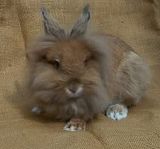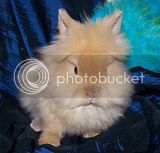I've been breeding lionheads for two years now - there have been a lot of changes in those two years....and the lionhead "look" is changing too - to a more rounded head and cat-like ears.
There are now FOUR active certificates of development on them (Bob Whitman pulled his at the last ARBA convention). The colors are (from
www.lionhead.us):
[line]
[align=left][font="Arial, Helvetica, sans-serif"]
BLACK The surface color is to be rich, jet black over the entire animal and extending well down the hair shaft. The undercolor is to be a dark slate-blue. Eyes- brown.
Faults: Fault animal for having faded color, scattered white hairs, or a light undercolor.
(Included on the SECOND CERTIFICATE - Theresa Mueller)
[/font][/align][font="Arial, Helvetica, sans-serif"]
BLUE: The surface color is to be dark blue over the entire animal, extending well down the hair shaft with a lighter blue undercolor.
Eyes â Blue-Gray
Faults: Fault animals for having faded color, scattered white [/font]
[font="Arial, Helvetica, sans-serif"]hairs or light under color[/font][font="Arial, Helvetica, sans-serif"]
(Included on the [font="Arial, Helvetica, sans-serif"]SECOND [/font]CERTIFICATE - Theresa Mueller)
BLUE TORTOISE: The body color is to be fawn, blending into a blue shading over the lower rump and carrying well onto the haunches. Top color should carry well down into the undercolor, blending into a cream color next to the skin. Top of the tail should match the body color, with the underside to be blue, blending into a cream next to the skin. Belly should match shadings, with cream undercolor. Head shadings should be darkest blue at the whisker bed, blending into a lighter shade along the jaw line, darkening again at the ear base and blending up into the ears to match the body color.
Eyes - Blue/Gray
Faults: Stray white hairs, faded shading
Disqualifications from competition:white belly or tail
[font="Arial, Helvetica, sans-serif"][font="Arial, Helvetica, sans-serif"][font="Arial, Helvetica, sans-serif"](Included on the FOURTH CERTIFICATE - Lynne Schultz)[/font][/font][/font]
[/font]
[font="Arial, Helvetica, sans-serif"]CHESTNUT AGOUTI -The surface color on the top sides of the body is to be a light brown, ticked with black. The intermediate band is to be a well defined orange over a dark slate-blue undercolor. The chest is to be a light cream or off white over a dark slate-blue undercolor. The undercolor of the belly is to be slate blue. The top of the tail is to be black, sparsely ticked with light brown, over a dark slate-blue undercolor. The nape of the neck is to be orange, with ears laced in black.
Eyes - brown.
Faults: Animals that are too light in the color of the intermediary band or undercolor or are to light or dark in surface color
[/font][font="Arial, Helvetica, sans-serif"]
(Included on the FIRST CERTIFICATE - Gail Gibbons)
[/font]
[font="Arial, Helvetica, sans-serif"]
ORANGE: Surface color to be a bright golden color, extending well down the hair shaft and carried evenly over the head, outer ear, front of foreleg, outside the hind legs and top of tail. Chest color is to be consistent with body surface color. Belly, back of forelegs, inside of hind legs top of hind feet and underside of lower jaw to be white with an off white undercolor. Lap spots should be present. Underside of tail and vent area, inside of ear, eye circles and under nostrils should be white. Eyes-Brown
Faults: Fault severely for smut or ticking on body or lacing on ears; lack of lap spots, color faded or washed out in appearance
[font="Arial, Helvetica, sans-serif"][font="Arial, Helvetica, sans-serif"][font="Arial, Helvetica, sans-serif"](Included on the FOURTH CERTIFICATE - Lynne Schultz)[/font][/font][/font][/font]
[font="Arial, Helvetica, sans-serif"]
POINTED WHITE Body color is to be pure white. Markings may be black, blue, chocolate or lilac, and must be present on the nose, ears, feet and tail. Allowances should be made for developing color on juniors. Toenails must show color.
Eyes--Pink.
Faults: Markings extremely faded; frosted appearance to the marking color.
Disqualifications from Competition: Any Tan Pattern marking appearing in the marking pattern. [/font]
[font="Arial, Helvetica, sans-serif"]
[font="Arial, Helvetica, sans-serif"](Included on the THIRD CERTIFICATE - Dawn Guth)[/font][/font]
[font="Arial, Helvetica, sans-serif"]
RUBY EYED WHITE Color is to be a pure white and uniform throughout. Eyes - Pink.
(Included on the FIRST CERTIFICATE - Gail Gibbons)[/font]
[font="Arial, Helvetica, sans-serif"]
SABLE POINT[/font][font="Arial, Helvetica, sans-serif"]
Color on the nose, ears, feet legs and tail is to be a rich sepia brown color. The marking color is to shade rapidly to a brown body color. The entire upper body is to be creamy brown color, with a lighter almost white undercolor. A slightly deeper body color may occur along the saddle but is not desirable. The ideal is an animal whose surface color is light enough to give good contrast with the point color.
Eyes - Brown
Faults: Blotchy surface color on body: markings too light to provide good contrast with the body.
(Included on the FIRST CERTIFICATE - Gail Gibbons)[/font]
[font="Arial, Helvetica, sans-serif"]
SIAMESE SABLE The surface color is to be a rich sepia brown on the head, ears, back, outside of legs, and top of the tail. The surface color will fade to a lighter sepia on the sides, chest, belly, inside of legs, and underside of the tail. Dark face color is to fade from the eyes to the jaws and all blending of color is to be gradual and free from blotched or streaks. The undercolor will be slightly lighter than the surface color.
Eyes - brown.
Faults: fault animals that have streaks, blotched or poor color blending, Scattered white hairs, or lack of darker color in the loin area is a fault (Included on the FIRST CERTIFICATE - Gail Gibbons)
[/font]
[font="Arial, Helvetica, sans-serif"]
SMOKE PEARL Color is to be a rich smoke gray on the face, ears, saddle, outside of legs, and top of the tail. Saddle color is to shade off gradually to a soft pearl gray on the flanks, chest and belly, inside of legs and underside of the tail. All blending of color is to be gradual and free from blotches or streaks. The under color will be slightly lighter than the surface color.
Eyes- Blue-Gray. Ruby cast permissible.
Faults: Blotchy shading, animals that are too dark or too light to show a contrast of shading.
[font="Arial, Helvetica, sans-serif"] (Included on the THIRD CERTIFICATE - Dawn Guth)[/font]
[/font]
[font="Arial, Helvetica, sans-serif"]TORTOISE: [/font][font="Arial, Helvetica, sans-serif"]The surface of the body is to be a rusty orange color on the loin, blending with a gray-black on the sides, rump, belly, head, feet and tail. The color is to extend well down the hair shaft to an off-white undercolor. Eyes - Brown.
[/font][font="Arial, Helvetica, sans-serif"]Faults: Stray white hairs; underside of tail light in color. [/font][font="Arial, Helvetica, sans-serif"]
(Included on the FIRST CERTIFICATE - Gail Gibbons)[/font]
[line]
My biggest concern is in using Sting, my dark siamese sable/seal buck. As an adult mane, he's keeping a VERY nice mane - something which doesn't happen that often. He carries the dwarf gene (which is a help) and he also has small ears (something I DO worry about because my does tend to have large ears - even if they weren't born here). I know that the ears are only worth 5 points but they are a dq if they are too long if I remember right. Also - he has nice clean ears- wool going up the ears is a dq.
Bun Jovi has thrown beautiful babies for Lisa Brown from Castle Gate Lionheads - he was a gift from her for my program because although he is black - he also carries tort and dilute. He is as nice or nicer than Sting but I really like the shadeds like siamese sable, etc.
I wouldn't be breeding right now except for the fact that I HAVE to get these girls bred once before they are too old.
[line]
Amy - just FYI - the chocolate one you're talking about is Chaucer. Really cute - but he's lost his mane. In addition, I realized after I'd bought him (I hadn't thought it all the way through) that he might carry the vienna gene and mess up my lines. I'm still thinking through all of my options - if I had a BEW doe - I could testbreed him and see if he carries it - but alas, I don't have a BEW doe.
Also - you may remember the black gal - she was the one that I would look at and go, "I don't know what in the world I got her for....look at those ears...".
Well - her ears are a bit long - BUT - she is GORGEOUS and her mane is beautiful and her body type is wonderful. So I'm going to go ahead and breed her after all. It helps that she is a sweetie...
Peg











































































